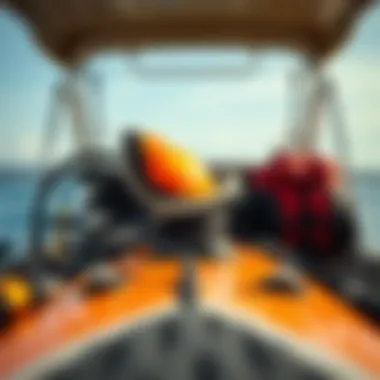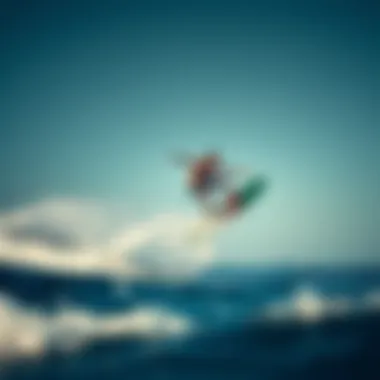Exploring Surfboarding Techniques and Safety Behind a Boat


Intro
Surfboarding behind a boat is a thrilling blend of two distinct watersports that offers unique challenges and unparalleled excitement. It combines the stability of wakeboarding with the fluidity of surfing, attracting those who cherish the ocean vibes and the rush of gliding over water. With a proper understanding of the techniques, safety precautions, and the right gear, enthusiasts can elevate their experience and enjoyment on the water. This article will explore the relationships between surfboarding and boat towing while focusing on the nuances that set this activity apart from traditional surfing.
Surfboard Technology
Innovations in Surfboard Materials
In the realm of surfboarding, materials make all the difference. Gone are the days when wooden boards ruled the waves. Today, boards are made with materials like expanded polystyrene and epoxy resin, which create lighter, more buoyant designs. For example, many modern surfboards utilize carbon fiber reinforcements that enhance strength without adding much weight. These innovative materials allow for greater maneuverability, especially when being towed behind a boat.
Moreover, the rise of eco-friendly materials has gained traction in recent years. Companies are crafting boards using sustainable practices, promoting both performance and environmental responsibility. For those looking for more information on surfboard materials, sites like Wikipedia provide detailed insights about the historical evolution and current trends in surfboard design.
Comparing Different Surfboard Shapes
Surfboard shapes play a crucial role in how well a rider can perform tricks and cut through the waves. There exists a variety of designs tailored to different styles of surfing. When surfboarding behind a boat, typical shapes include the fish and shortboard:
- Fish: Known for its wide tail and shorter length, this board excels in maintaining speed while maneuvering quickly. Ideal for beginners and thrill-seekers alike, it's great for catching waves.
- Shortboard: This option is preferred by advanced riders looking to execute more aggressive moves. Shortboards are more skinnier and designed for high-performance surfing.
Ultimately, the choice of surfboard shape can dramatically influence the experience. Selecting a board suited to one’s skill level and riding style when being towed behind a boat is essential.
Surfing Techniques
Essential Skills for Beginners
Mastering the fundamentals is key for anyone new to surfboarding behind a boat. A few essential skills include:
- Balancing: Holding your center of gravity low will help maintain stability as you cut through the wake.
- Starting Position: Begin with your knees bent and hands gripping the board’s rails. Once the boat accelerates, stand up with grace and find your rhythm!
- Turning and Stopping: Learning to edge your weight on the heels or toes can help with steering and stopping effectively.
As you practice these techniques, realizing how your body interacts with the board and water is paramount for building confidence.
Advanced Maneuvers for Experts
For more experienced surfers, pushing the envelope with advanced techniques is a natural progression. These maneuvers can include:
- Carving: Drawing smooth arcs in the water can enhance both speed and control.
- Aerials: Launching off the wake for airborne tricks demands precision and commitment.
- Transitions: Switching stances requires agility and familiarity with directional changes.
Experts will often harness the boat’s speed to help execute these maneuvers, showcasing the thrilling intersection of boat dynamics and surfboarding.
"Surfing is like the ocean; it has its highs and lows. Learning to ride those waves behind a boat can be empowering and exhilarating all at once."
Investing time in mastering these skills can lead to an exciting journey in the world of surfboarding behind a boat.
As we dive deeper into each aspect of this exhilarating sport, understanding the various techniques, technology, and safety protocols will equip you to fully enjoy this thrilling fusion of surfing and boating.
Prologue to Surfboarding Behind a Boat
Surfboarding behind a boat opens up an exhilarating world of water sports, blending the thrill of surfing with the rush of being towed across smooth lakes or rivers. This unique activity draws enthusiasts who seek adventure, enjoyment, and a taste of freedom on the water. As the boat pulls you along, the strategically crafted waves create an engaging bed of water, ideal for practicing tricks or simply enjoying the ride. The backdrop of nature enhances the experience, making it a popular choice among outdoor lovers.
The Importance of This Topic
Grasping the basics of surfboarding behind a boat holds significance for several reasons. First, it’s paramount to understand that this sport differs from traditional surfing. While traditional surfing relies on ocean waves, surfboarding behind a boat leverages the boat's speed to create the right conditions for riding. This distinction is essential; beginners might think they can jump in without prior preparation, but there are nuances to consider. The boat's speed, weight, and the surfer's balance can dictate the success of the day on the water.
Moreover, this form of surfboarding garners a shared community experience. Whether you're a seasoned pro or just dipping your toes in, coming together with fellow enthusiasts leads to camaraderie and shared tips. The conversations that arise, perhaps about gear choices or ideal locations to ride, reflect the essence of the surf culture that thrives beyond ocean fronts.
In addition, there’s an educational aspect. As interest in surfboarding behind a boat grows, so does the need for understanding safety protocols, equipment selection, and environmental factors. Those who engage in this sport should be encouraged to learn about the ecosystem around them and how their activities can impact local waterways. A well-rounded knowledge creates not just better performance but fosters respect for the environment.


Of course, like any sport, the thrill exists. The sensation of gliding over the water, feeling the wind whip through your hair while maneuvering turns or attempting tricks cannot be overstated. For many, it's not just about the ride; it's about the joy of mastering what initially seemed challenging.
Key Elements and Benefits
- Skill Development: Surfers can build a range of skills, from balance to coordination, enhancing overall athletic performance.
- Accessibility: With advancements in boat technology, surfboarding is becoming increasingly accessible; one doesn’t need to wait for the perfect beach conditions.
- Flexible Locations: Unlike traditional surfing, which is often restricted to certain coastal areas, boat surfboarding can be enjoyed in numerous lakes and rivers.
- Safety First: Learning about the importance of gear—like life jackets and signal systems—ensures a safe and enjoyable experience for all.
As we embark on this journey into the details of techniques, equipment, and best practices, it becomes clear that surfboarding behind a boat is not just about the thrill, but also about understanding the intricate dynamics that make it a compelling adventure. This comprehensive guide aims to equip both rookies and veterans alike with the knowledge to enhance their experience aboard.
The Mechanics of Boat Towing
When we talk about surfboarding behind a boat, understanding the mechanics of boat towing becomes crucial. The relationship between the boat and the rider on the surfboard can dramatically influence the overall experience. It’s essential to know how speed, water conditions, and the type of boat used can impact not just the thrill of the ride, but also the safety and effectiveness of the sport.
The towing efficiency relies on several key factors. Proper speed is fundamental; it sets the stage for the interaction between the boat's wake and the rider's maneuverability. If the boat moves too fast, it may create a chaotic wake difficult to navigate, while too slow might not give the desired lift or flow. Understanding how these variables play into surfboarding can help enthusiasts tailor their experience effectively.
Understanding Speed and Water Conditions
Speed is not just a number when it comes to surfboarding. The right speed creates a friendly wave. Typically, a speed range of 15 to 25 miles per hour is optimal for most surfers. This varies based on the board shape and rider experience. It's like finding that sweet spot – not too much, not too little.
Moreover, different water conditions can either enhance or disrupt the experience. Flat and calm waters are ideal for beginners, allowing them to practice balance and technique without the interference of chop or swell. In contrast, those with more experience might prefer to surf in mildly turbulent conditions, where waves offer challenges and more opportunities for tricks.
One should also consider the impact of wind on water surface conditions. A brisk breeze can create unwanted waves making it tougher for the rider. It's advisable for boat drivers and surfers alike to keep an eye on weather conditions. Here are a few tips when thinking about speed and water:
- Before towing: Assess water conditions and adjust speed accordingly.
- During the ride: Communicate with the boat operator. Use hand signals if necessary.
- Post-ride: Evaluate your performance in different conditions to improve.
Optimal Boat Types for Surfboarding
Choosing the correct boat is another precondition of having an enjoyable experience. Not all boats are created equal when it comes to towing methods for surfboarding.
For instance, wakeboard boats are designed specifically to generate larger wakes, making them perfect for surfers who desire a bigger wave to ride. Their hull shapes facilitate the needed wake formation which allows riders to catch and maintain their balance more easily. Alternatively, flat-bottom skiffs, though not as common for surfboarding, can be a choice for those looking for a more casual experience on lakes or rivers.
Some specific boat brands, like MasterCraft and Malibu, are known for their surf-friendly features, integrating technology that allows for customizable wake shapes. Here are some considerations for selecting the appropriate boat:
- Hull type: A deep-V or modified V-hull is preferable for smoother rides with better wave generation.
- Ballast systems: Boats equipped with these can adjust weight distribution, enhancing wake size and quality.
- Tow points: Ensure the boat has appropriate tow rings or points that allow for safe and secure attachment of the tow rope.
"A poorly chosen boat or wrong speed can turn a day of fun into a tumultuous mess, affecting both rider and experience."
In summary, understanding the mechanics of boat towing aids surfers to make informed decisions about their ride, ensuring a thrilling yet safe adventure on the water. Whether you are just starting or you're a seasoned pro, knowing these dynamics will pave the way for a more enjoyable surfboarding experience.
Equipment Considerations
When it comes to surfboarding behind a boat, the right equipment can be the difference between a memorable experience and a frustrating outing. Understanding the nuances of your gear is essential, as it directly impacts performance, safety, and enjoyment.
Choosing the Right Surfboard
Selecting a surfboard for behind-the-boat riding is not as straightforward as picking a board for ocean waves. It’s vital to consider board shape, size, and material. A board designed for boat surfing typically has a shorter length and wider width compared to traditional surfboards. This design enhances stability while being towed over water, allowing riders to maintain their balance even in choppy conditions.
- Length and Width: Opt for a board between 4 to 6 feet, which offers maneuverability. The width should be around 20 to 24 inches to provide enough volume for flotation.
- Tail Shape: A squared or rounded tail gives better planing stability when being towed, enabling smoother transitions and easier turns.
- Material: Epoxy boards are lightweight and sturdy, giving riders more control while reducing drag. Conversely, a traditional polyurethane board might be heavier and less responsive, which can impede performance.
Personal preference also plays a crucial role; some surfers might like the feel of a thicker board that allows for better floating, whereas others might prefer a thinner one for agility. Consider trying out some boards before making a commitment, as comfort and confidence on your chosen board can’t be overstated.
Accessories for Enhanced Performance
In addition to the surfboard, accessories can greatly enhance the surfing experience behind a boat. Here are some essential items to consider:
- Leash: A sturdy leash is non-negotiable. Ensure it’s long enough to keep your board within reach but not so long that it becomes a hazard.
- Wetsuit: Depending on water temperature, a wetsuit can keep you warm and protect against minor injuries. Choose one that fits snugly without restricting movement.
- Wakeboard Vest: While these vests may not be standard, they provide padding and can be beneficial for added buoyancy. Always choose one that fits well, allowing for maximum mobility without feeling cumbersome.
- Tow Rope: A rope specifically designed for boat surfing can make a significant difference. Look for a rope that’s strong enough to withstand the tension and includes a handle that’s easy to grip, allowing for smooth starts and stops.
Each of these accessories contributes tangible benefits that can elevate your experience, optimizing performance and ensuring safety.


"Choosing the right gear not only enhances your performance but can make your time on the water more enjoyable and safe."
Carefully consider what works best for you based on your style and comfort level. Investing in quality equipment not only boosts your performance but also fosters a deeper appreciation for this exhilarating sport.
Techniques for Successful Surfboarding Behind a Boat
Surfboarding behind a boat is more than just a ride on the water; it's a delicate balance of skill, technique, and awareness. Mastering this dynamic activity encompasses various techniques that ensure not just enjoyment but safety and performance. By understanding how to maneuver, balance, and execute tricks, participants can maximize their experience while minimizing risks. The success of any boat surfboarding experience hinges upon these essential techniques, making them pivotal to any enthusiast's arsenal.
Proper Stance and Balance
When it comes to surfboarding behind a boat, the stance you adopt can set the stage for the entire ride. Positioning yourself correctly is paramount in achieving both stability and agility. Stand with your feet shoulder-width apart on your board; this width fosters a solid base. Bend your knees slightly to lower your center of gravity, improving balance and allowing you to absorb the motion of the boat's wake.
Maintaining an upright posture is crucial. Keep your back straight and shoulders relaxed. Your arms should be positioned at your sides or extended slightly for better control.
Another essential element is weight distribution. Shift your weight forward when you want to gain speed, and lean back if you need to slow down or maintain stability in choppy waters. It’s akin to dancing with the boat as you ride the waves—it demands synergy and rhythm.
Regular practice can help you find your most natural stance. Many surfers suggest viewing the act of surfboarding not only as a sport but also as a meditative experience. Just like that, practicing your stance can become second nature.
Executing Turns and Tricks
Once you have a solid stance, the real fun begins—it's time to execute turns and tricks. This aspect of boat surfboarding is what elevates the experience from simple riding to an exhilarating display of skill.
For turns, begin by shifting your weight in the direction you want to go. If you're aiming to turn left, subtly lean toward your left foot while extending your right arm forward. This shift in weight and movement of your arms will help guide your board in that direction. Remember, smoothness is your best friend; abrupt movements can lead to wipeouts.
Tricks, on the other hand, require a bit more finesse. Starting with basic jumps can help build your confidence—simply compress your knees as you approach a section of the wake and then extend upwards off the edge. Once you’ve got that down, you can add 180-degree spins or grabs. Don't rush it; mastering one move at a time is the best way to progress.
"Success isn't just about what you accomplish in your life; it's about what you inspire others to do."
Be sure to assess the conditions before attempting more complex movements. A choppy sea or strong wind can affect your balance and control. Practicing in various conditions can ultimately set you up for success and adaptability.
In summary, the techniques of surfboarding behind a boat—the correct stance, balance, and the execution of turns and tricks—are fundamental to not only enjoying but excelling in this thrilling water sport.
For more detailed resources on surfing techniques, check sites like Wikipedia on Surfing or the US Coast Guard’s water sports safety.
Safety Protocols and Best Practices
Safety protocols in surfboarding behind a boat are as critical as having the right gear or mastering techniques. This aspect ensures that the thrill of gliding over the waves does not give way to unforeseen accidents. Engaging in any water sport presents a unique set of risks, necessitating that spectators and participants alike remain vigilant.
When it comes to surfboarding, the landscape shifts from purely recreational to a more structured activity, laden with guidelines that, if adhered to, greatly enhance safety. These protocols not only safeguard the individual surfer but also other boaters, water skiers, and wildlife in the area. Ignoring safety is like buying a ticket to a roller coaster without understanding the ride—risky and potentially hazardous.
Importance of Life Jackets
The onus of personal safety begins with one straightforward piece of equipment: the life jacket. An often underappreciated ally, the life jacket is not merely a flotation device but a crucial guardian during surfboarding endeavors.
- Visibility: A brightly colored life jacket makes it easier for boat operators and fellow surfers to spot riders in the water. This point cannot be overstated; having a clear line of sight can prevent accidents.
- Buoyancy: In the event of a fall, which, let’s be honest, can be frequent for both newbies and veterans, a good life jacket keeps you afloat and reduces the risk of drowning.
- Regulations: Most governing bodies require life jackets for individuals engaging in water sports. Being compliant isn’t just about following rules; it’s about embracing safety.
In a nutshell, wearing a life jacket is a no-brainer. It could be the simple action that prevents a tragic story from unfolding—and nobody wants to end their surfing tales on a murky note.
Designated Signal System
As thrilling as catching waves can be, understanding how to communicate effectively is equally vital. This is where a designated signal system comes into play. Think of it as the unspoken language navigating surfboarders and boat operators safely through shared waters.
A few basic symbols or gestures can establish clarity and prevent misunderstandings that might lead to accidents:
- Raised Hand: This typically signifies stopping immediately. It’s crucial for both the surfer and the boat to understand when a break is needed, perhaps due to changing conditions or a swimmer in the vicinity.
- Arm Extended Sideways: This can indicate that the surfer is about to perform a trick or maneuver, allowing the boat operator to anticipate and adjust speed accordingly.
- Thumbs Up: An essential sign of affirmation, thumbs up confirms that everything is alright. This mutual understanding alleviates concerns and keeps spirits high on the water.
Using a uniform signaling method decreases the chances of miscommunication, which can lead to accidents. It's like learning the ropes of a new job—understanding the lingo is half the battle.


Safety on the surf is not just a set of rules; it’s a culture that respects both participants and the environment. Remember, a good day on the water means everyone goes home safe.
For surfboarding enthusiasts and operators alike, embracing these safety protocols and understanding their importance sets the stage for memorable experiences without unnecessary hazards, ensuring that the excitement of surfboarding behind a boat never gives way to regret.
Environmental Considerations
In the world of surfboarding behind a boat, there's more than just the thrill of skimming the water to consider. Environmental factors play a pivotal role in ensuring that this engaging activity isn't just a joy for participants but is also sustainable for the ecosystems we enjoy. In essence, understanding how our actions affect the aquatic environment is fundamental to maintaining its health and vibrancy.
Impact of Boat Traffic on Water Ecosystems
Ingestion of the scenery and the excitement of riding waves often make riders oblivious to the side effects of boat traffic on local water ecosystems. Too much boat activity can lead to issues like water pollution and disruption of aquatic habitats. For instance, the propeller wash from a boat can stir up sediment on the seabed, which can smother vulnerable species such as seagrass and corals. This sediment, when suspended in the water, can also block sunlight needed for photosynthesis, jeopardizing the entire food chain.
Furthermore, the noise generated by motorized boats can disturb marine life, disrupting breeding patterns and natural behaviors of species like dolphins and fish. It's not just about what you can see above the water; the thriving ecosystems below can be sensitive to our fun above it. Just like a dance, if the rhythm is off, it can throw everything out of balance.
In summary, the influence of boat traffic on water ecosystems underscores the importance of mindful boating practices. A good, keen eye on our surroundings and an understanding of those impacts can help soothe our conscience while we enjoy this exhilarating sport.
Sustainable Practices for Boat Surfboarding
To keep our waterways clean and our marine inhabitants safe, adopting sustainable practices while surfboarding behind a boat is a must. Here are several strategies to ensure that the enjoyment of this sport does not come at a cost to the environment:
- Choose Designated Areas: Surfboarding in designated zones minimizes disruption of sensitive habitats. Local regulations often indicate these areas to safeguard wildlife.
- Practice Clean Boating: Clean the hull of your boat regularly to prevent invasive species spreading from one area to another. Use eco-friendly cleaning products when maintaining equipment.
- Mind the Wake: Adjusting your speed and minimizing the wake can significantly reduce erosion and damage to shorelines and habitats.
- Respect Wildlife: Keeping a respectful distance from wildlife encourages natural behaviors and leads to a healthier ecosystem.
- Educate Yourself and Others: Sharing knowledge about environmental conservation can create a ripple effect in the community, enhancing understanding and responsible behaviors.
By implementing these practices, surfers and boaters can ensure that their love for the sport aligns with safeguarding the ecosystems that nurture it. Engaging with nature should come with a sense of responsibility; after all, what’s fun for us needs to be fun for the environment too.
"Water is the source of life, and preserving its beauty for future generations is our shared responsibility."
Incorporating these sustainable actions not only improves the health of the waters but also enhances the overall experience of surfboarding behind a boat. A clean, healthy environment amplifies the excitement of catching waves, making it worthwhile in every sense.
Cultural Aspects of Boat Surfboarding
The cultural aspects of boat surfboarding play a significant role in shaping the activity into a communal and vibrant part of surf culture. It’s not just about the thrill of carving through the water behind a boat; it’s also about the connections formed among surfers and the larger community. Embracing the cultural facets enriches the experience, fostering an environment where sharing knowledge, camaraderie, and passion for the sport thrive.
Community and Engagement within Surf Culture
At the heart of boat surfboarding is its community. Surfers gather to share tips on technique, recommend gear, and engage in lively discussions about the latest trends. This sense of community fosters inclusion and encourages newcomers to dive into the sport without hesitation.
- Local Collectives: Many areas have local surfing clubs dedicated to boat surfboarding, where members organize meet-ups, workshops, and outings. These clubs not only promote safety but also provide support as individuals embark on their surfboarding journeys.
- Mentorship: Experienced surfers often mentor novices, passing down invaluable skills and insights about water conditions and equipment handling. This relationship not only elevates the sport but also strengthens bonds within the community.
Furthermore, social media platforms serve as a bustling hub for engagement within the surfboarding community. From sharing exhilarating clips on Instagram to discussing their experiences in detail on forums like Reddit, surfers utilize digital spaces to connect with like-minded enthusiasts.
"The community aspect of boat surfboarding brings everyone together—it's like a big family where everyone’s welcome to join in and share their passion."
Events and Competitions Focused on Boat Surfboarding
Events and competitions centered around boat surfboarding add a spirited dimension to this cultural landscape. These gatherings serve not only as a showcase of talent but also as celebrations of the sport itself.
- Local Competitions: Many regions hold friendly competitions, giving surfers an opportunity to test their skills in a pressure-free environment. These events often feature categories for different skill levels, ensuring that both beginners and veterans can participate and enjoy.
- Festivals: Some areas host surfing festivals that include boat surfboarding exhibitions, live music, and various stalls for food and gear. These festivals create a festive atmosphere, attracting families and non-surfers, bridging the gap between different generations and increasing interest in the sport.
- National and International Events: Events at a higher level draw attention from media and sponsors alike. Competitive leagues can draw serious athletes, showcasing impressive tricks and techniques while promoting boat surfboarding on a wider scale.
Overall, the cultural aspects surrounding boat surfboarding emphasize inclusivity, knowledge-sharing, and community engagement. Such elements enhance the experience, making it not just a sport, but a lively, interconnected tradition that continues to evolve, embracing new generations of surfers.
The End
In wrapping up our exploration of surfboarding behind a boat, we must consider how this activity not only offers an adrenaline rush but also deepens our connection with water sports culture. Surfboarding behind a boat serves as a bridge between traditional surfing and other water activities, allowing enthusiasts to experience the exhilaration of riding waves in a novel setting.
A few critical points have emerged throughout this article, emphasizing the multifaceted nature of this sport:
- Techniques and Skills: Surfboarding demands a specific set of skills, from balance to timing. Understanding how to position oneself on the board and react to the boat's momentum are vital skills that can elevate any rider's performance.
- Safety Measures: Engaging in this activity involves inherent risks. Adhering to safety protocols, such as wearing life jackets and understanding proper hand signals, is not just advisable but essential for ensuring a safe outing.
- Environmental Responsibility: Boat surfboarding can impact aquatic ecosystems, which necessitates responsible practices. By being conscious of our actions on the water, we can help preserve the natural beauty of our environments.
Moreover, the cultural significance of this sport cannot be overstated. As new enthusiasts join the ranks, a community-oriented spirit emerges. Surfboarding behind a boat encourages camaraderie, with friends and families sharing moments that transform mere outings into memorable experiences.
As you consider taking up surfboarding behind a boat, remember that mastery comes with practice. Stay informed, respect the environment, and revel in the joy that comes from this thrilling water sport. The blend of technical skill, safety consciousness, and communal engagement makes surfboarding behind a boat an enriching pursuit, appealing to surfers and outdoor enthusiasts alike.
To further broaden your understanding and capabilities, connect with dedicated communities online, such as on forums like Reddit or seek clubs that focus on water sports. Resources on such platforms can provide valuable tips, ongoing discussions, and even real-time safety updates within your area, ensuring that your experience remains both enjoyable and secure.



